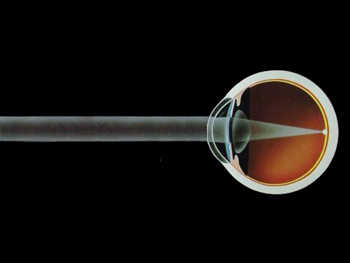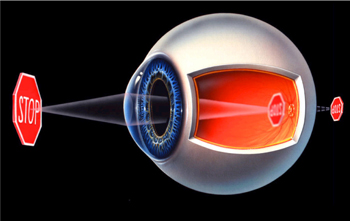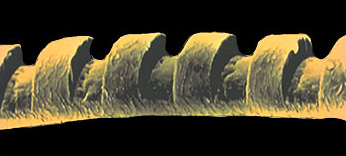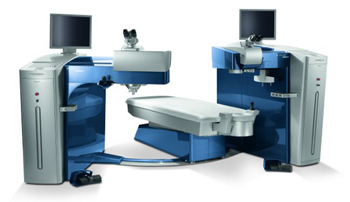LASIK / Refractive
- How does the human eye see?
- What is Myopia?
- What is Hyperopia?
- What is Astigmatism?
- What is Presbyopia?
- How do we correct errors of refraction (EOR)?
- What is an Excimer Laser?
- What is LASIK?
- What is All Laser or Bladeless LASIK?
- What are the preparations needed for LASIK?
- What should be expected after LASIK?
- What is PRK?
- What is LASEK?
- What is EpiLASIK?
How does the human eye see?
A normal human eye is likened to a camera. Light rays pass through a series of lenses (tear film, cornea and human lens) and focus on the film (retina) for a person to be able to see things clearly.

What is Myopia?
Myopia is the medical term for "nearsightedness", a condition wherein the eyes can see close objects but are unable to see distant objects clearly. Compared to the normal eye, a myopic eye is longer from front to back. As a result, light is focused in front of the retina, rather than on the retina, resulting in the perception of a blurred image. To focus images, myopes need minus (biconcave) lenses which diverge the light rays onto the retina.

What is Hyperopia?
Hyperopia is the medical term for "farsightedness", which is actually a misnomer. Compared to the normal eye, a hyperopic eye is shorter from front to back. As a result, light is focused behind the retina, rather than on the retina, resulting in the perception of a blurred image. To focus images, hyperopes need plus (biconvex) lenses which converge the light rays onto the retina. Since hyperopia is the opposite condition of myopia, and one needs plus lenses to correct it rather than minus lenses, the direct English translation is termed "farsightedness" to contrast it from"nearsightedness." However, most hyperopes below 40 years of age with lens grades below +1.50 diopter have enough focusing ability to see well for both far and near. They just have more effort to see for near. As they approach 40, or if their refractive grade approaches +2.00 diopter and above, then difficulty for near becomes more manifest. Actually, for grades above +2.00 diopter, vision for far is also impaired. Hence, the misnomer.

What is Astigmatism?
In order to have normal undistorted vision, the cornea should be smooth and spherical or equally curved in all meridians. Some eyes have some degree of astigmatism, or ovalness, to their cornea. Instead of being shaped like a basketball, the astigmatic eye is shaped more like an American football. Therefore, there is distortion or tilting of the images due to asymmetric bending of the light rays. This is sometimes perceived by the individual as a "shadow effect" or a doubling of the image.

What is Presbyopia?
Presbyopia is not an error of refraction, but rather, an age-related loss of the focusing power of the eye for near. It usually sets in as one approaches the age of 40 or thereabouts. Normal and farsighted individuals usually require reading glasses once they reach this age. A presbyopic person with a moderate amount of nearsightedness may need only to remove his corrective spectacles for near work or reading. As this ability to accommodate or focus for near progressively wanes with advancing years, the need for reading glasses and the grade of the reading glasses increases over time. The Excimer laser does not have any effect on the focusing ability of the eyes. Therefore, it cannot be used to permanently treat presbyopia.

How do we correct errors of refraction (EOR)?
Eyeglasses and contact lenses properly focus the light rays on the retina and thus "correct" EORs. However, as soon as these devices are removed, the eye is again unable to focus light properly. To permanently correct EORs, the corneal surface must be reshaped: flattened for myopia, steepened for hyperopia, and made more spherical for astigmatism. This can be achieved with the use of the Excimer laser.
What is an Excimer Laser?
The Excimer laser is a cold laser, which works via photochemical ablation. Unlike other lasers that utilize thermal energy or heat to burn tissue, Excimer lasers make use of an argon-fluoride gas mixture to break the molecular bonds of corneal tissue. When covalent bonds are broken, the molecules of the corneal stroma can no longer exist in the same space they previously occupied. As a result, fragments of corneal tissue rapidly expand and are ejected at high speed from the corneal surface. The Excimer laser is computer-controlled, allowing precise removal of tissue to the micron level.

Vision correction by the Excimer laser was approved by the United States Food and Drug Administration (US FDA) in 1995 and is among the most commonly performed outpatient clinical procedures in ophthalmology. Over a million people with myopia (nearsightedness), hyperopia (farsightedness) and astigmatism in over 40 countries worldwide have undergone this procedure and have been enjoying functional vision without glasses and contact lenses ever since. Sight-threatening complications are exceedingly rare. This combination of high success and low complication rates has resulted in exceptional patient satisfaction.
American Eye Center holds the distinction of being the country's premier ophthalmic laser center. Since 1995, close to 35,000 eyes have been treated and although our services have long expanded to include treatment of other eye problems, American Eye Center continues to be known for its vast experience in Refractive Surgery. No other Center in the country comes close to the track record of American Eye Center with regards to LASIK and our long list of happy patients can attest to that.
Our Center is equipped with the integrated WAVELIGHTÆ Refractive Suite, the world's fastest refractive platform featuring the WAVELIGHTÆ EX500 Excimer Laser and the WAVELIGHTÆ FS200 Femtosecond Laser (refractivesuite.com).

What is LASIK?
LASIK is an acronym for Laser-Assisted In Situ Keratomileusis. It is the procedure wherein the Excimer laser treatment to correct error of refraction is applied on the bed of the cornea under a hinged corneal flap. LASIK has been proven to be effective in treating a wide range of myopia, hyperopia and astigmatism. It is an outpatient procedure that takes 5-7 minutes per eye but the actual laser exposure lasts less than a minute. Because the flap preserves the superficial layer of the cornea, visual recovery and healing are dramatically rapid. Patients regain functional vision in 4 to 12 hours. With LASIK, there is accelerated visual recovery, enhanced quality of post-operative vision, early refractive stability, and minimal post-operative discomfort.

What is All Laser or Bladeless LASIK?
A femtosecond refers to one quadrillionth of a second or 10-15 of a second. As a reference, a blink of an eye lasts around 200 to 300 millisecond and light takes 1.3 seconds to reach the moon. Also, light takes 100 femtoseconds to travel across a human hair.
All Laser LASIK or Blade-less or Blade-free LASIK is made possible with a groundbreaking innovation in Refractive surgery which is the femtosecond laser. The thin flap is made when the femtosecond laser directs its beam beneath the corneal surface. With a high repetition rate, this laser creates an array of gas bubbles within the corneal layers in 6 seconds; and as a result, this array of gas bubbles allows easy separation of the corneal flap. The flap is then lifted and the corneal bed is ready for the Excimer laser treatment that takes away the grade of the eye. The duration is dependent on the grade of the eye ñ about 1.4 seconds per diopter. After the laser treatment, the flap is repositioned and adheres spontaneously to the underlying bed.
American Eye Center takes pride in being the only refractive center in the Philippines which has the integrated WAVELIGHTÆ Refractive Suite, the world's fastest refractive platform featuring the WAVELIGHTÆ EX500 Excimer Laser and the WAVELIGHTÆ FS200 Femtosecond Laser (refractivesuite.com). A very distinct advantage of this system over other available systems is that the Excimer Laser is networked with the Femtosecond Laser. With this system, All Laser LASIK becomes very convenient for the patient. The patient is asked to lie on a motorized bed that swings from one laser to the other, shortening the duration of the entire procedure. The patient stays in the LASIK suite for less than 20 minutes.
The WAVELIGHT Refractive Suite is the world's fastest refractive platform and in refractive surgery, speed is the key to patient comfort, faster turnover time, accuracy of treatment and more predictable outcomes or results.
The previous standard of care in making the LASIK flap is with the use of an ophthalmic instrument, the automated microkeratome. This microkeratome is placed on a ring with tracks and is made to advance and make a pass across the cornea, making a thin flap, after which it returns to its starting position.
What are the preparations needed for LASIK?
It is advisable to come in for LASIK screening so our EyeMDs can discuss your options and determine if you are eligible for the procedure. A retina examination is also done for all patients prior to the procedure. We recommend that you set an appointment for this and allot 2 hours for the complete screening process, which should be done on a separate day from the LASIK surgery day.
Soft contact lenses should be discontinued at least 1 week before the actual LASIK procedure. Rigid gas permeable contact lenses or hard contact lenses should be discontinued for at least 6 weeks.
What should be expected after LASIK?
After the patient steps out of the LASIK Suite, he or she can go straight home. There will be some amount of discomfort, described as a sandy feeling or foreign body sensation, sensitivity to light and continuous tearing. This usually lasts for 3 to 4 hours and it is advisable for the patient to simply sleep it off. There will be a course of antibiotic and anti-inflammatory eyedrops that will be provided and these are to be instilled for about a week. Functional vision is usually attained once the discomfort wears off.
What is PRK?
Another procedure done with the Excimer Laser is PRK or Photorefractive Keratectomy. Unlike LASIK wherein treatment is done under a corneal flap, PRK involves de-epithelializing or scraping the outer surface of the cornea and applying the Excimer laser on the surface of the cornea, leaving an abrasion or wound on the surface which takes 3 to 4 days to heal. During this time, the patient may feel discomfort and likewise, target vision is achieved in about 2 weeks.
What is LASEK?
LASEK is an acronym for Laser-assisted Sub-epithelial Keratectomy. Just like PRK, the cornea is also de-epithelialized but in LASEK, the outer surface is exposed to an alcohol solution, weakening the epithelial cells. The surgeon is then able to peel the epithelial sheet to expose the corneal surface. Once Excimer laser treatment is done, the epithelial sheet is brought back to cover the treated area. Recovery time is the same as PRK. Although this procedure does not make use of a blade, it is by no means the same as All Laser LASIK or Blade-less LASIK. LASEK is not the same as LASIK.
What is EpiLASIK?
EpiLASIK is a method of refractive surgery where an epi-keratome is used to slide across the cornea and like LASIK, there is a blade that makes a thin flap. Once flap is lifted, Excimer laser treatment is done, after which, the flap is repositioned into place.
A normal human eye is likened to a camera. Light rays pass through a series of lenses (tear film, cornea and human lens) and focus on the film (retina) for a person to be able to see things clearly.

What is Myopia?
Myopia is the medical term for "nearsightedness", a condition wherein the eyes can see close objects but are unable to see distant objects clearly. Compared to the normal eye, a myopic eye is longer from front to back. As a result, light is focused in front of the retina, rather than on the retina, resulting in the perception of a blurred image. To focus images, myopes need minus (biconcave) lenses which diverge the light rays onto the retina.

What is Hyperopia?
Hyperopia is the medical term for "farsightedness", which is actually a misnomer. Compared to the normal eye, a hyperopic eye is shorter from front to back. As a result, light is focused behind the retina, rather than on the retina, resulting in the perception of a blurred image. To focus images, hyperopes need plus (biconvex) lenses which converge the light rays onto the retina. Since hyperopia is the opposite condition of myopia, and one needs plus lenses to correct it rather than minus lenses, the direct English translation is termed "farsightedness" to contrast it from"nearsightedness." However, most hyperopes below 40 years of age with lens grades below +1.50 diopter have enough focusing ability to see well for both far and near. They just have more effort to see for near. As they approach 40, or if their refractive grade approaches +2.00 diopter and above, then difficulty for near becomes more manifest. Actually, for grades above +2.00 diopter, vision for far is also impaired. Hence, the misnomer.

What is Astigmatism?
In order to have normal undistorted vision, the cornea should be smooth and spherical or equally curved in all meridians. Some eyes have some degree of astigmatism, or ovalness, to their cornea. Instead of being shaped like a basketball, the astigmatic eye is shaped more like an American football. Therefore, there is distortion or tilting of the images due to asymmetric bending of the light rays. This is sometimes perceived by the individual as a "shadow effect" or a doubling of the image.

What is Presbyopia?
Presbyopia is not an error of refraction, but rather, an age-related loss of the focusing power of the eye for near. It usually sets in as one approaches the age of 40 or thereabouts. Normal and farsighted individuals usually require reading glasses once they reach this age. A presbyopic person with a moderate amount of nearsightedness may need only to remove his corrective spectacles for near work or reading. As this ability to accommodate or focus for near progressively wanes with advancing years, the need for reading glasses and the grade of the reading glasses increases over time. The Excimer laser does not have any effect on the focusing ability of the eyes. Therefore, it cannot be used to permanently treat presbyopia.

How do we correct errors of refraction (EOR)?
Eyeglasses and contact lenses properly focus the light rays on the retina and thus "correct" EORs. However, as soon as these devices are removed, the eye is again unable to focus light properly. To permanently correct EORs, the corneal surface must be reshaped: flattened for myopia, steepened for hyperopia, and made more spherical for astigmatism. This can be achieved with the use of the Excimer laser.
What is an Excimer Laser?
The Excimer laser is a cold laser, which works via photochemical ablation. Unlike other lasers that utilize thermal energy or heat to burn tissue, Excimer lasers make use of an argon-fluoride gas mixture to break the molecular bonds of corneal tissue. When covalent bonds are broken, the molecules of the corneal stroma can no longer exist in the same space they previously occupied. As a result, fragments of corneal tissue rapidly expand and are ejected at high speed from the corneal surface. The Excimer laser is computer-controlled, allowing precise removal of tissue to the micron level.

Vision correction by the Excimer laser was approved by the United States Food and Drug Administration (US FDA) in 1995 and is among the most commonly performed outpatient clinical procedures in ophthalmology. Over a million people with myopia (nearsightedness), hyperopia (farsightedness) and astigmatism in over 40 countries worldwide have undergone this procedure and have been enjoying functional vision without glasses and contact lenses ever since. Sight-threatening complications are exceedingly rare. This combination of high success and low complication rates has resulted in exceptional patient satisfaction.
American Eye Center holds the distinction of being the country's premier ophthalmic laser center. Since 1995, close to 35,000 eyes have been treated and although our services have long expanded to include treatment of other eye problems, American Eye Center continues to be known for its vast experience in Refractive Surgery. No other Center in the country comes close to the track record of American Eye Center with regards to LASIK and our long list of happy patients can attest to that.
Our Center is equipped with the integrated WAVELIGHTÆ Refractive Suite, the world's fastest refractive platform featuring the WAVELIGHTÆ EX500 Excimer Laser and the WAVELIGHTÆ FS200 Femtosecond Laser (refractivesuite.com).

What is LASIK?
LASIK is an acronym for Laser-Assisted In Situ Keratomileusis. It is the procedure wherein the Excimer laser treatment to correct error of refraction is applied on the bed of the cornea under a hinged corneal flap. LASIK has been proven to be effective in treating a wide range of myopia, hyperopia and astigmatism. It is an outpatient procedure that takes 5-7 minutes per eye but the actual laser exposure lasts less than a minute. Because the flap preserves the superficial layer of the cornea, visual recovery and healing are dramatically rapid. Patients regain functional vision in 4 to 12 hours. With LASIK, there is accelerated visual recovery, enhanced quality of post-operative vision, early refractive stability, and minimal post-operative discomfort.

What is All Laser or Bladeless LASIK?
A femtosecond refers to one quadrillionth of a second or 10-15 of a second. As a reference, a blink of an eye lasts around 200 to 300 millisecond and light takes 1.3 seconds to reach the moon. Also, light takes 100 femtoseconds to travel across a human hair.
All Laser LASIK or Blade-less or Blade-free LASIK is made possible with a groundbreaking innovation in Refractive surgery which is the femtosecond laser. The thin flap is made when the femtosecond laser directs its beam beneath the corneal surface. With a high repetition rate, this laser creates an array of gas bubbles within the corneal layers in 6 seconds; and as a result, this array of gas bubbles allows easy separation of the corneal flap. The flap is then lifted and the corneal bed is ready for the Excimer laser treatment that takes away the grade of the eye. The duration is dependent on the grade of the eye ñ about 1.4 seconds per diopter. After the laser treatment, the flap is repositioned and adheres spontaneously to the underlying bed.
American Eye Center takes pride in being the only refractive center in the Philippines which has the integrated WAVELIGHTÆ Refractive Suite, the world's fastest refractive platform featuring the WAVELIGHTÆ EX500 Excimer Laser and the WAVELIGHTÆ FS200 Femtosecond Laser (refractivesuite.com). A very distinct advantage of this system over other available systems is that the Excimer Laser is networked with the Femtosecond Laser. With this system, All Laser LASIK becomes very convenient for the patient. The patient is asked to lie on a motorized bed that swings from one laser to the other, shortening the duration of the entire procedure. The patient stays in the LASIK suite for less than 20 minutes.
The WAVELIGHT Refractive Suite is the world's fastest refractive platform and in refractive surgery, speed is the key to patient comfort, faster turnover time, accuracy of treatment and more predictable outcomes or results.
The previous standard of care in making the LASIK flap is with the use of an ophthalmic instrument, the automated microkeratome. This microkeratome is placed on a ring with tracks and is made to advance and make a pass across the cornea, making a thin flap, after which it returns to its starting position.
What are the preparations needed for LASIK?
It is advisable to come in for LASIK screening so our EyeMDs can discuss your options and determine if you are eligible for the procedure. A retina examination is also done for all patients prior to the procedure. We recommend that you set an appointment for this and allot 2 hours for the complete screening process, which should be done on a separate day from the LASIK surgery day.
Soft contact lenses should be discontinued at least 1 week before the actual LASIK procedure. Rigid gas permeable contact lenses or hard contact lenses should be discontinued for at least 6 weeks.
What should be expected after LASIK?
After the patient steps out of the LASIK Suite, he or she can go straight home. There will be some amount of discomfort, described as a sandy feeling or foreign body sensation, sensitivity to light and continuous tearing. This usually lasts for 3 to 4 hours and it is advisable for the patient to simply sleep it off. There will be a course of antibiotic and anti-inflammatory eyedrops that will be provided and these are to be instilled for about a week. Functional vision is usually attained once the discomfort wears off.
What is PRK?
Another procedure done with the Excimer Laser is PRK or Photorefractive Keratectomy. Unlike LASIK wherein treatment is done under a corneal flap, PRK involves de-epithelializing or scraping the outer surface of the cornea and applying the Excimer laser on the surface of the cornea, leaving an abrasion or wound on the surface which takes 3 to 4 days to heal. During this time, the patient may feel discomfort and likewise, target vision is achieved in about 2 weeks.
What is LASEK?
LASEK is an acronym for Laser-assisted Sub-epithelial Keratectomy. Just like PRK, the cornea is also de-epithelialized but in LASEK, the outer surface is exposed to an alcohol solution, weakening the epithelial cells. The surgeon is then able to peel the epithelial sheet to expose the corneal surface. Once Excimer laser treatment is done, the epithelial sheet is brought back to cover the treated area. Recovery time is the same as PRK. Although this procedure does not make use of a blade, it is by no means the same as All Laser LASIK or Blade-less LASIK. LASEK is not the same as LASIK.
What is EpiLASIK?
EpiLASIK is a method of refractive surgery where an epi-keratome is used to slide across the cornea and like LASIK, there is a blade that makes a thin flap. Once flap is lifted, Excimer laser treatment is done, after which, the flap is repositioned into place.



